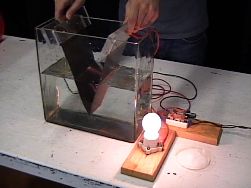Categories: Featured Articles » Novice electricians
Number of views: 46360
Comments on the article: 0
How water conducts electricity
 There are two types of charge carriers in substances: electrons or ions. The movement of these charges creates an electric current.
There are two types of charge carriers in substances: electrons or ions. The movement of these charges creates an electric current.
All metals are characterized by electronic conductivity. Violation of the crystal lattice impedes the movement of electrons (for example, when an impurity is added) and thereby increases the resistivity.
Liquids are characterized by ionic conductivity. Distilled water practically does not conduct current. But if you add a soluble salt to the water, which dissociates into ions, then the more salt and the greater part of it decomposes into ions, the higher the conductivity of the solution. This is the first factor affecting conductivity (ion concentration).
Other factors: ion charge (an ion with a charge of +3 carries three times more current than with a charge of +1); ion mobility (heavy ions move slower than light). A solution that conducts electric current is called an electrolyte.
A large number of factors affecting the conductivity of the electrolyte, leads to the fact that this conductivity must be measured experimentally.
Such measurements are absolutely necessary when evaluating water quality, therefore, environmentalists produce serial devices for measuring conductivity. Moreover, jars with solutions having standard conductivity are produced (with an accuracy of 0.1%), while it is agreed at what temperature such conductivity takes place).
The conductivity can be measured qualitatively in the installation shown in Figure 1. In a plate of insulating material, holes are drilled into which a LED and a resistor are fixed, to which a 9-volt battery is connected.
Fig. 1. Home-made installation for measuring the conductivity of water
On the one hand, the long leads of the LED and resistor can be lowered into the test solution. The conductivity of the solution is qualitatively evaluated by the brightness of the LED. When shorting long leads, the LED lights up at maximum brightness (this is a check of the correct operation of the circuit). This setting completely safe to use.
The article was published in the journal "RA-Electric"
See also at bgv.electricianexp.com
:

